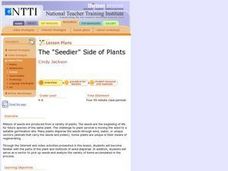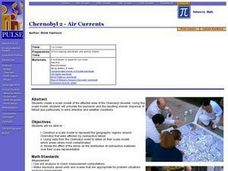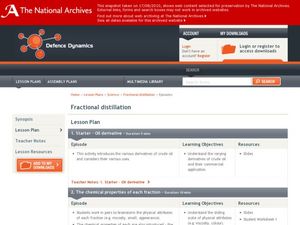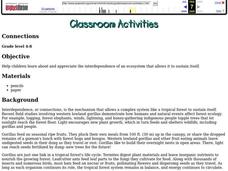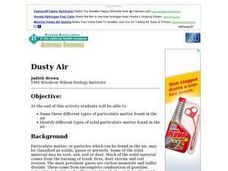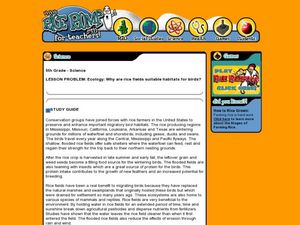K12 Reader
What’s Eating You?
Introduce your class to producers, consumers, and pollinators with a reading passage. Class members read the text and respond to five related questions.
Biology Junction
Seed Plants: Gymnosperms and Angiosperms
One of the reasons plants found success on land relates to seed development. Scholars learn about many different forms of seeds and how they changed over time. It describes the structure and function of many different types of seeds in...
Curated OER
Let's Get Carried Away
Students discover how seeds travel from their parent plants in search of water, sunlight, and nutrients, and conduct experiments in which they note characteristics that encourage seed dispersal by means of wind, water, animal carriers,...
Curated OER
The "Seedier" Side of Plants
Students demonstrate seed dispersal vectors through role-play, analyze seed types, identify plant parts, list seven conditions plants need in order to grow, and describe how seeds travel.
Curated OER
Biogeography
Third graders listen to a teacher led lecture about species living in different parts of the world. They study how the species spread to different parts of the world and examine the concept of dispersal. As a class, 3rd graders...
Curated OER
Chernobyl 2 - Air Currents
Students create a scale model of the affected area of the Chernobyl disaster. Using this scale model, they simulate the explosion and the resulting uneven dispersal of fallout due particularly to wind direction and weather conditions.
Curated OER
Lesson 2: Timber Harvesting Methods and Logging Methods
Whereas very few learners study this topic, this lesson plan is written well! An organized and detailed teaching outline explains thinning, clearcutting, seed tree, and shelterwood methods of harvesting timber. Beautiful diagrams can be...
Curated OER
Designer Seeds
Learners enjoy the challenge of the seed structure design component of this activity and become very competitive as they seek to create a seed that travel farthest.
Curated OER
Fractional Distillation
Students brainstorm the different uses of petroleum distillates. In this chemistry lesson, students explain the process of fractional distillation. They analyze the impact of oil extraction to the environment.
Curated OER
Seed Transport
Students explore botany by completing KWL worksheets. In this seed transportation lesson, students define a list of vocabulary terms associated with botany and seedlings before completing worksheets based on assigned text. Students...
Houghton Mifflin Harcourt
Zombie Ants
One of the creepiest and coolest natural occurrences is a great forum for data analysis and discussion! Explore the phenomenon of zombie ants, or ants infected with the Cordyceps fungus, with a series of activities and experiments. Kids...
Curated OER
Natural Similarities and Opposites in Two Poems by Joseph Ceravolo
In this antonyms and synonyms learning exercise, students look in two short poems by Joseph Ceravolo to find opposite or contradictory statements that express many sides of a feeling. Students answer 25 short answer questions about the...
Curated OER
How Much Is an Ecosystem Worth?
Students examine the value of ecosystems. They read and analyze an article, evaluate ecosystem services, research the benefits of biomonitors, and design a public service announcement.
Curated OER
Good News - We're on the Rise!
Students build and observe a simple aneroid barometer to discover changes in barometric pressure and weather forecasting. They graph changes in barometric pressure for two weeks and make weather predictions.
Curated OER
CONNECTIONS
Students study the interdependence of an ecosystem that allows it to sustain itself. They examine the Western lowland gorillas for an example.
Curated OER
Plant Reproduction
Students investigate seeds and plant life by creating a germination chamber. In this botany lesson, students investigate the relationship between flowers and the fruit they produce while examining the structure of the flower. Students...
Curated OER
Dusty Air
Students discover the types and amounts of particulate matter found in the air. They collect particulates using a Petri dish coated with Vaseline then classify and count the collection under a stereoscope.
Curated OER
Life Cycles of Mosses, Ferns, and Conifers
In this plant life cycle learning exercise, students compare the life cycles of mosses, ferns, and conifers. This learning exercise has 15 fill in the blank and 10 short answer questions.
Curated OER
Polar Day: Arctic Clean Up
Students explore the concept of pollution. In this environmental stewardship lesson, students examine primary sources to research the complexity of pollution and its effect on the Arctic.
Curated OER
Ecology: Why Are Rice Fields Suitable Habitats for Birds?
Fifth graders discover the uses for rice by reading about the habitats of certain birds. In this agriculture lesson, 5th graders research birds from the Gulf Coast and California and their reasons for living in rice fields. Students...
Curated OER
Dune Plan Adaptations
Students tour Coal Oil Point Reserve. They locate the species of plants that are on the handouts ,and describe the different adaptations used by plants in their specific area of the dunes.
Curated OER
Particulate Matter in the Air
Students conduct an inquiry exploring the different kinds of particulate matter in the air. They name three different types of particulate matter found in the air and identify different types of solid particulate matter found in the air...
Curated OER
Plants Reproduce and Grow in Various Ways
Third graders take a walk around the outside of the school and examine their clothing to see if they picked up any seeds while on their walk. They discuss how seeds travel and how a new plant thus can form. They then observe root...





